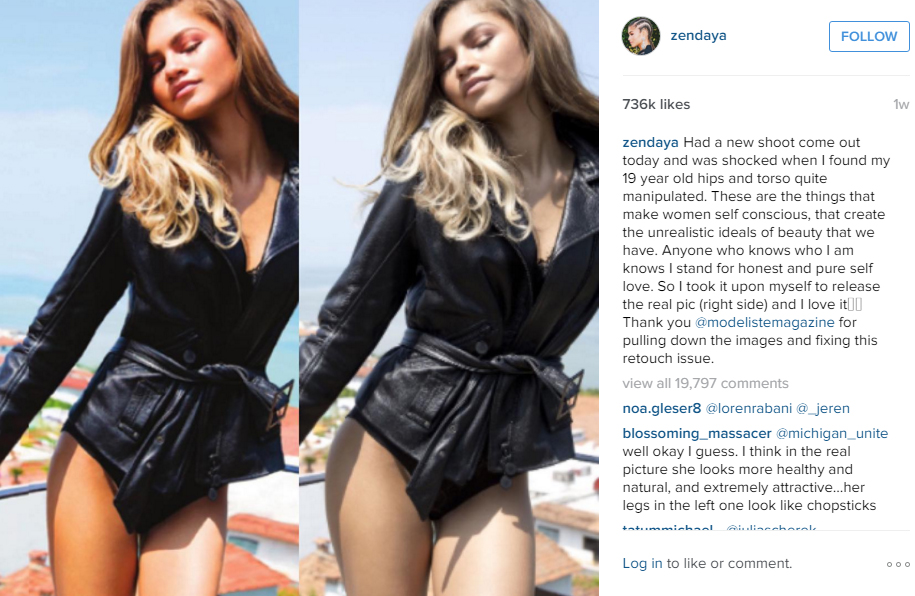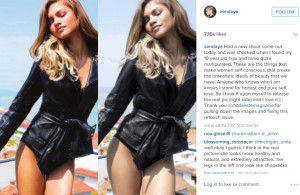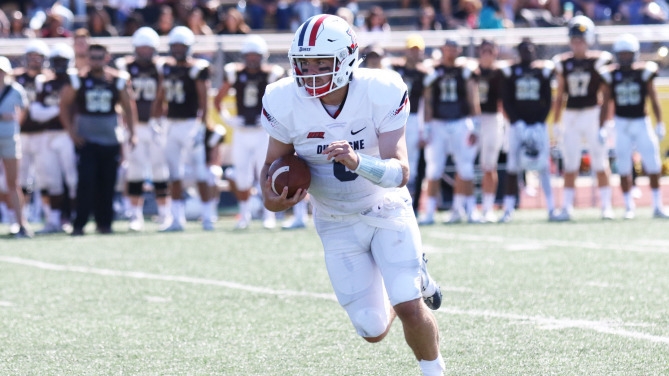
By Catherine Clements | Student Columnist

Click. Color. Cut. Blur.
All these actions can be performed in a matter of minutes on a single image. But does the fact that we can edit photographs mean that we should? How far is too far when it comes to editing an image?
The line was drawn last week for singer, actress and model Zendaya after her photoshoot with Modeliste Magazine. Photo editors took it upon themselves to slim Zendaya’s hip and waist size amongst other features without her consent. Modeliste was ready to publish this altered version of Zendaya until she called out the magazine on Instagram. This 19-year-old is a strong advocate of natural beauty and was left in disbelief after seeing the final edits of her image.
Zendaya addressed the issue on Instagram, comparing the original image and the edited version side-by-side. Anyone scrolling through could spot the differences immediately. The most notable changes were her darkened skin and severely trimmed hip and waist size. Zendaya captioned her photo, “Had a new shoot come out today and was shocked when I found my 19-year-old hips and torso quite manipulated.”
Photo editing is meant to enhance images, not change them completely. It’s one thing to fix a red eye or blur a pimple, but it is another to reshape someone’s body. Zendaya called out the extreme Photoshop job by saying, “These are the things that make women self conscious, that create the unrealistic ideals of beauty that we have. Anyone who knows who I am knows I stand for honest and pure self love.”
Zendaya ended her caption by thanking Modeliste Magazine “for pulling down the images and fixing this retouch issue.” The unedited photograph will appear in the Modeliste’s November issue.
Plenty of celebrities use Photoshop, but more and more individuals are speaking against it. Stars like Kate Winslet, Brad Pitt and Jamie Lee Curtis are making their opposition to photo editing clear.
Zendaya’s advocacy against these changes is admirable. It’s awesome that not only did she address the issue, but she did it on such a public platform. With over 14 million Instagram followers, Zendaya sparked a conversation and awareness about photo editing.
Modeliste Magazine reacted to the Instagram post with a letter from its editor, Amy McCabe. McCabe wrote that the editing to Zendaya’s photo did not align with their values and instead, “Modeliste advocates positive body image, self love and the empowerment of women.”
Despite it taking Zendaya speaking up for McCabe to reevaluate the image, she addressed body issues presented by the media and admitted photos can create an “unrealistic and often confused expectation of what is real.” With this being said, I am disappointed she would have okay’d this edit.
McCabe assuredly knew that overly-edited photos are dangerous, and she should have acted proactively instead of retroactively. By making her position known, Zendaya is bringing to light the ethical question of Photoshop.
With our generation being so media-dense, we are constantly being pushed into societal definitions of beauty. Everywhere you look in movies, advertisements and social media, there are images that make us want to compare ourselves to others. But how can we? These industries have makeup artists, designers, professional photographers and most importantly, photo retouchers.
To compete with Photoshop is an unimaginable task. Eyes can be widened, cellulite can be diminished and breasts can be enhanced. Photoshopped images cannot be the standard for beauty as they are unrealistic to human capabilities.
The problem with Photoshop is that it is an expected part of production. Magazine editors or ad managers know an image has been Photoshopped and therefore assume the public knows too. Audiences may be aware that some editing occurs, but I think it is safe to say that most don’t know to what extent.
In 2004, Dove began its Campaign for Real Beauty. The most significant piece of its promotion was its launch of an imaging editing video. In the video, the company took a model and showed step-by-step how her image was edited to create the final photograph. It was shocking. One would hardly believe that the two images were of the same person. Dove’s campaign has made a clear effort to showcase a wide array of models and produce attainable images for girls and women.
After the success of Dove’s campaign, more companies are moving towards embracing natural beauty for both men and women. Whether it’s a diverse spread of models or untouched images, companies like Modcloth, Aerie, Seventeen Magazine and Darling Magazine are moving towards the right direction.
Photo editing may create an aesthetically pleasing image, but it also creates unachievable standards for people everywhere.



